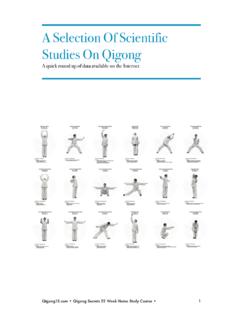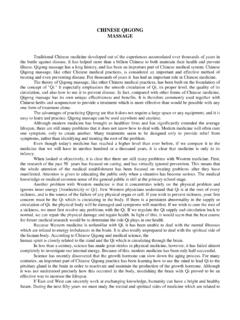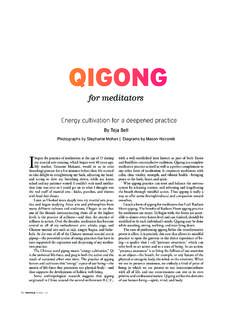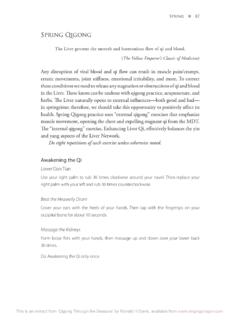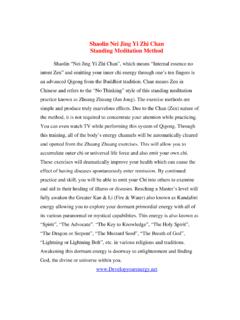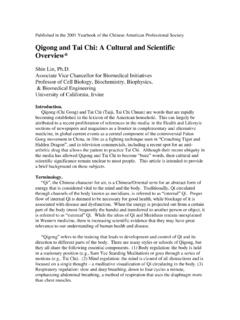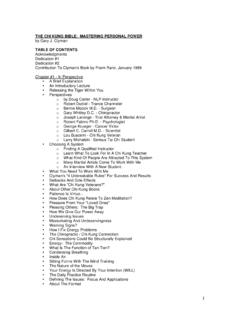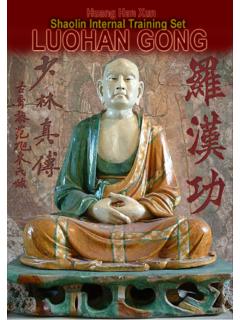Transcription of Qigong Eye Exercises & Natural Eye Care
1 Qigong Eye Exercises & Natural Eye Care Qigong vision therapy incorporates both eye Exercises and other Natural eye care habits. In addition, tai chi Qigong is holistic in its perspective on health, looking at both root causes and healing of disease. That is why treatment always focuses on whole mind and body. Since vision therapy does not work well in isolation, it is best practiced with the following lifestyle changes: Diet Poor health is often due to diet. Toxins can build up through the foods we consume, and the eyes are especially vulnerable. A case in point, disorders such as glaucoma, cataracts and macular degeneration are often diet-related and/or linked to conditions such as vitamin deficiencies, diabetes, high blood pressure or high cholesterol. Even eye strain can be affected by diet. Changing your diet from typical junk food binging to a diet predominant in fresh fruit and vegetables can often reduce or even relieve many symptoms of eye strain.
2 Therefore, where diet is concerned, be sure to include a high concentration of fresh fruit and vegetables, high in antioxidants and vitamins. Keep preservatives and artificial sweeteners to a minimum. Also, separate your acid-based foods from alkaline foods. Especially, do not combine fruits with other proteins and starch. Fruits and other acid-based foods require a digestive enzyme that is different from digestive enzymes of other foods. Since fruit is the more easily digestible food, always consume fruit at least a half hour before any other food, and preferably, your meat and starch last. If you follow these simple rules of food combining, you will find you will experience fewer digestive problems and hence a lower toxicity level for your body to handle. Secondly, after any exercise, including eye Exercises , drink lots of clean purified water, distilled or reverse osmosis to flush out toxins and lubricate organs for healthy functioning.
3 Drinking adequate amounts will clean out toxins and mineral deposits even in your eyes and keep your eyes well lubricated. Yogic Breathing Oxygen is essential to life, yet so many of us take breathing for granted, and most of the time we do it unconsciously. Qigong yogic breathing allows us to optimize our breathing by taking deeper breaths and by maximizing our oxygen intake. But yogic breathing does much more. It also promotes healthy circulation of blood, flushes out toxins and promotes relaxation. Most importantly, it helps generate and circulate healing chi that is vital to health, longevity, and even life itself. That is why yogic breathing is so integral to many of the Qigong eye Exercises and meditation. Most of the Exercises will emphasize basic diaphragmatic breathing, but depending on the eye condition being treated, there are other techniques and variations as well.
4 That is why very few traditional Qigong practitioners suffer from disorders such as macular degeneration, myopia, cataracts, glaucoma, or even from simple eye strain. Qigong yogic breathing, incorporated in eye Exercises and other Qigong meditative practices helps keep the body free of toxins. It lubricates joints, clears the mind, promotes circulation, relaxes the muscles and promotes health, healing and well-being. Basic Qigong Yogic Breathing Exercise A chi kung/ Qigong yogic breathing exercise that will generate and circulate the chi energy for vibrant health, energy and longevity? Also known as slow breathing, diaphragmatic breathing, deep breathing, or inaccurately, belly breathing, these yogic breathing techniques make efficient use of oxygen. Since the brain uses up to eighty percent of the oxygen we breathe in, chi kung/ Qigong yogic breathing Exercises not only supply oxygen to the body for energy, but also nourishes the brain with oxygen, resulting in mental clarity and alertness (see Qigong Health Benefits).
5 When we breathe improperly, not enough oxygen goes to the brain and we become sluggish and unable to concentrate. If you have never done chi kung/ Qigong yogic breathing or diaphragmatic breathing before, you need to first establish a baseline by breathing normally and counting your breaths per minute. Most people take quick shallow breaths when they breathe. When they breathe from the top half of their chest they are actually wasting more than half of their lung capacity. To compensate, they tend to breathe more rapidly, as much as twenty or more breaths per minute. The breathing exercise I'm about to show you is a general chi kung/ Qigong exercise that follows the principles of all diaphragmatic breathing techniques. (See Qigong /Chi Kung Breathing Techniques). After establishing a baseline of your usual breathing pattern, you need to follow these steps: 1.
6 You can do this breathing exercise sitting or lying down. If you are sitting, make sure you're not slouching, but you should still be relaxed. If you find this difficult to do, the easiest position is to lie down on your back with your hands relaxed at your sides and a book on your stomach. The book is an optional visual aid so that you can see better how your lower abdomen expands and collapses as you breathe. 2. Inhale slowly, visualizing filling your belly with air. This is why yogic breathing is sometimes inaccurately called "belly breathing". What actually happens is that when you expand your lower abdomen, you automatically pull down the diaphragm, a muscular membrane located in the solar plexus. Pulling down the diaphragm allows the lungs to expand and fill up with air to their maximum capacity. ginners. pause. 3. Pause briefly for about half a second before exhaling.
7 As you breathe out, see your lower abdomen collapse within itself, releasing all the air. Of course, air does not really come in and out of the abdomen, but for the sake of visualization, it makes the yogic breathing easier to practice, especially for be4. Remember to pause again briefly before taking the next inhalation. 5. Try this breathing exercise for a few minutes until you begin to fall into a Natural rhythm: breathe in slowly, pause, breathe out slowly, Then begin timing yourself for one minute: an inhalation and exhalation count together as one breath. You should find that yogic breathing is much slower than your usual breathing pattern. If you are like most beginners, when you practice this breathing exercise, you should be breathing about eight breaths per minute. As you get better, you will find your breathing will begin to slow down even more perceptibly to two to four breaths per minute.
8 We call this tortoise breathing, because a tortoise breathes very slowly. It uses oxygen very efficiently, and thus is able to live a very long life. When you are able to do this breathing exercise on a regular basis until it becomes unconscious and you can do it in your sleep, not only will you feel more relaxed, but you will experience a whole multitude of health benefits, including: mental clarity, better concentration, a stronger immune system and longevity. When your breathing is habitually slow, you begin to gain control of normally involuntary body functions, such as heart beat, body temperature and blood pressure. Control of these functions is known as biofeedback. Why is this important? Because it gives you control over your health, your autoimmune system and even how long you live. If you can slow down your heart, you can extend your life span!
9 Take a look at all living creatures around you: the faster their heartbeat, the faster they age and the shorter their life span. Children grow up very quickly because they have faster heartbeats than adults. As they grow older, their hearts start to slow down and their growth rate also slows down. On the other hand, most babies and toddlers, even though they may have faster heartbeats, are also belly breathers. In other words, they are Natural chi kung/ Qigong practitioners! If you have ever looked at these children breathe, you would see how their bellies pump in and out like bellows. Little wonder they have so much energy, sleep so soundly, and we adults can barely keep up with them! (See Qigong Health Benefits). Want to experience their energy and youth? Practice the yogic breathing exercise outlined in the steps above. Just ten minutes a day will make a big difference to your health and well being.
10 In contrast, if you ever look at dying people taking their last few breaths in life, you will see how shallow their breathing is. Healthy people practice slow breathing all the time. That is what gives them life. When you breathe from the chest up, you are cutting your breathing capacity in half and thus, your energy. Worse, if you ever start to breathe from your upper half of your chest and throat, then you will find yourself on your last legs of life! What does chi kung or Qigong actually mean? Qi, also phonetically spelled chi, means breath, and gong, or kung, means skill, practice, or art. In other words chi kung or Qigong is literally, the yogic art of slow breathing. Its main purpose is to promote health and longevity. The breathing exercise outlined above is just one of many < purposes. health specific with them of some website, this on available techniques breathing Qigong kung> This particular breathing exercise will help with relaxation and mental clarity, as well as set a foundation for all other chi kung/ Qigong breathing Exercises .

